Note
Hey—I’m not sure if the question I sent came through the first time,so I will send it again,but moving on:Hey there!It’s the same anon who asked you if any sea slugs were harmless to humans(barring the sap-sucking ones),as well as the same anon who also wanted to check up on you the first time!(I distinctly remember telling you my favorite nudibranch was the Bornella Anguilla species,alongside the fact that I draw sea slug inspired characters/sea slug characters in general.However,the main question I wanted to ask was if you know any comprehensive guides on the nudibranch species of the state of Florida?I’ve stumbled across a few photo galleries that some diving photographers have posted,compounded with the fact that I have found at least some nudibranch species over on iNaturalist.((Some of them are interesting,while others just don’t catch my eye as much.I was wondering if you any more sea slugs that live within that particular state—as I would love to draw them at some point.(Besides the ones you’ve posted already)).
The links to the galleries in question:
https://lindaiphotography.com/local-sea-slugs/
The iNaturalist Guide:
https://www.inaturalist.org/guides/16187?tags%5B%5D=florida
Hi!!
Sorry for not getting around to answering this earlier, I've just continued to be very busy in real life! Unfortunately I know very little about what you can find in Florida - I'm based out of the Pacific Northwest, so have learnt little about the specific species found on the other side of the country. My best bet for finding nudibranch species in Florida would be to use iNaturalist (which it seems you've done already!). Beyond their guides, if you just search 'Nudibranch' and click 'View Observations' then make sure you're looking at the map view, you can zoom in to Florida and see every nudibranch species someone has recorded on iNaturalist in the area. This link might get you to what I'm talking about:
I hope that helps, sorry I can't be more specific! But good luck in your drawing endeavours : )
6 notes
·
View notes
Note
Hey,it’s the same person who wanted to check up on you to see if you were doing ok! Now,I’m not sure if you’ve gotten this question before,but I wanted to ask,are there any nudibranchs you know of that are harmless to humans?(Barring the sap-sucking sea slugs).
Hi!!
A good question! I'm sure many of you have heard about the Blue Sea Dragon nudibranch (Glaucus atlanticus) and how it can be a very bad experience for you if you pick it up, due to the nematocysts it keeps from its Cnidarian prey! However, most nudibranchs I can think of are less harmful to humans... it mainly is far worse for the slug in question! Sea slugs are very squishy and very delicate, and so touching them is generally a bad idea.
I also am based out of the west coast of North America, where I expect things to be generally less toxic than things in the tropics. But I haven't heard of too many harmful nudibranchs. A lot use toxins from their prey (coral, sponges, etc) to be a bad meal for their predators, but usually humans aren't a part of this picture!
So moral of the story, while I think many nudibranchs are harmless to humans, please don't go around touching (or especially eating!) any of them : )
#it is time for me to make one post and then disappear for months again!!!#just very busy with work : )#but hope everyone still likes all the old cool slug posts that just sit on this blog!
27 notes
·
View notes
Text

Verco's chromodorid (Verconia verconis) is a dorid nudibranch found along the coast of southern Australia. A relatively large sea slug, it typically is about 6cm long. It's named after Sir Joseph Verco (1853 - 1933), a physician from South Australia who was also very interested in shell collecting and marine biology! The slug itself blends in remarkably well with its main food (not pictured), a pink sponge.
Photo - Robin Gwen Agarwal (anudibranchmom on iNaturalist)
446 notes
·
View notes
Text
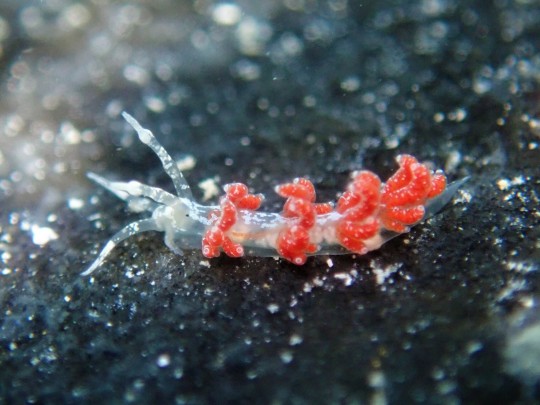
Favorinus auritulus is an aeolid nudibranch found in shallow waters off the coast of the eastern Atlantic, from Brazil to Florida. Interestingly, it was once found unusually north in Chesapeake Bay, though no further sightings have occurred. One common food source for this nudibranch is the eggs of other sea slugs!
Photo - Ben Eddy (b_eddy on iNaturalist)
229 notes
·
View notes
Text
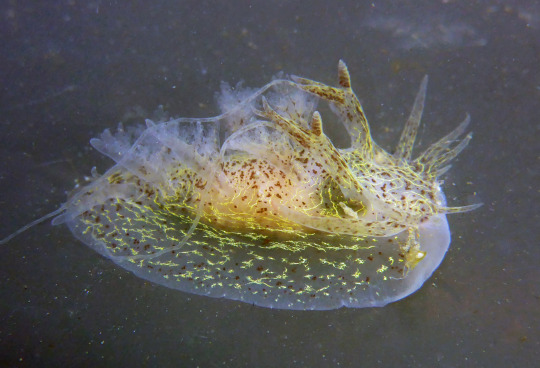
The Threaded Nudibranch (Pseudobornella orientalis) is a dendronotid nudibranch originally described in Japan and found along the western Pacific, but also recently found in California. It likely made its way to San Francisco by hitchhiking on ships, joining about six other non-native sea slug species found in the area. In fact, the one in this picture was the first one to be found (and reported) in North America! The slug itself has distinctive bright yellow vein-like pigmentation as well as long tentacles extending past its rhinophores (the sensory organs on its head), earning it its common name.
Photo - Robin Gwen Agarwal (anudibranchmom on iNaturalist)
273 notes
·
View notes
Text
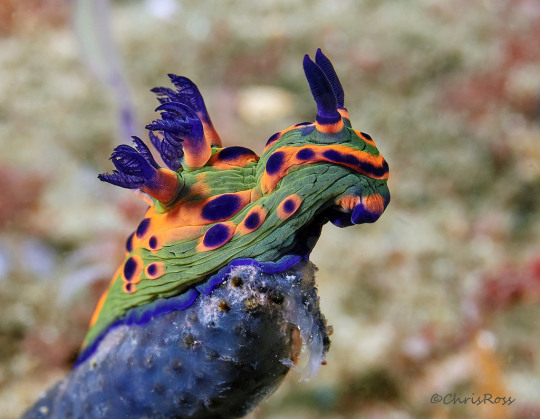
The 'Donut Nembrotha' (Nembrotha rosannulata) is a dorid nudibranch found in eastern Australia, particularly around Cabbage Tree Island. It is a relatively recently discovered species, having been described in 2008 - because of that, there is still a lot more to learn about this colourful creature!
Photo - Chris Ross (@chrisross on iNaturalist)
1K notes
·
View notes
Note
Hey so,I’ve known about your blog for quite a long time, and I absolutely love the dedication you put into researching these little guys! (I’m a huge fan of sea slug/nudibranchs)! In fact, I’ve even used some—if not most of the species you’ve posted about as inspiration to produce my own original character designs. I’m a traditional concept artist by the way. Oh and by the way,of all the species you have posted, the sap sucking sea slugs—plus Bornella Anguilla are my favorites. I just wanted to check up on this blog to see if you were doing ok.
Hi!!
Messages like this mean so much to me!! It's so wonderful that people not only enjoy my slug posts, but wonder where I've gone when I drop off the face of the internet for a bit : ).
In short, I've been very very busy with real life things! I started this blog midway through highschool and just graduated from university this year, so it's been a long ride. But throughout my undergrad I've done a lot of marine biology research and courses (which included seeing my own share of wild nudibranchs!), focusing on marine invertebrates and seaweed! (And for the dedicated slug nerds, for an upper year marine invert class I did a whole paper on kleptoplasty in sap-sucking sea slugs; if anyone is interested in reading it let me know!!)
I've queued up a few posts for this week. Not sure how frequently I'll be able to post, but I'm hoping to be a little more active on this blog again now that I'm out of school!
(Also, I would absolutely love to see your sea-slug-inspired concept art, if you are alright with sharing it! I designed a few sea-slug based characters of my own back in high school, so I know just how fun they can be to reimagine)
37 notes
·
View notes
Text

Cyerce elegans is a wonderful sacoglossan sea slug found in the Pacific Ocean, from the east coast of Africa to Hawaii. It is known to feed on algae, and grows up to 5cm long. While it certainly looks elegant, the name is a bit unfortunate as it gives it the same abbreviation (C. elegans) as a very, very well studied nematode.
Photo source - rafi1 on iNaturalist
2K notes
·
View notes
Text

Asteronotus hepaticus is a large dorid nudibranch, growing up to 20cm long! It's a picky eater, and only eats sponges. It can be found throughout the Indo-West Pacific.
Photo source - craigjhowe on iNaturalist
522 notes
·
View notes
Text
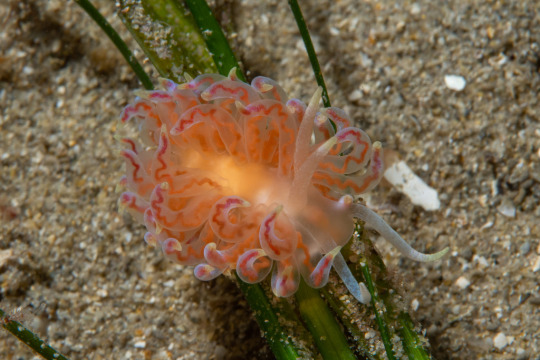
Phyllodesmium poindimiei is a brightly coloured aeolid nudibranch that can grow up to 5 cm long. It feeds on soft corals, and can be found throughout the Indo-Pacific. P. poindimiei near Hawaii eat a specific type of octocoral that is invasive to the area, so the slugs' use for controlling invasive octocoral abundance has been studied - though the results were not promising.
Photo source - christophermark on iNaturalist
309 notes
·
View notes
Text
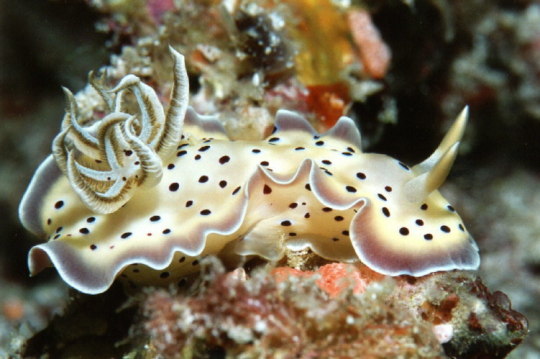
Goniobranchus tritos is a dorid nudibranch found by the Maldives. It can grow to around 4.5 cm long, and is closely related to the Fried Egg Nudibranch (which, if you follow the link, you'll see I said it was Chromodoris annulata - the whole Goniobranchus genus used to be considered part of the Chromodoris genus!)
Photo source - erwinkoehler on iNaturalist
#goniobranchus tritios#nudibranch#marine biology#sea slug#ocean#science#i just want to say for posterity that Goniobranchus has existed long before I made that post with the fried egg nudibranch#I just hadn't done enough research then apparently
347 notes
·
View notes
Text

Aeolidia loui, aka the 'shag-rug nudibranch', is an aeolid nudibranch known to live around the west coast of North America. They feed on sea anemones, and can even use the algal symbionts originally within the anemones they eat for extra sugar production!
Photo source - dpom on iNaturalist
466 notes
·
View notes
Note
hi!! i really enjoy ur blog and i've developed an interest in nudibranch (they're so cool)! do you or your followers know of any interesting documentaries or videos about them? 🌊 🐌
That's a great question! Here are the first videos that popped to my mind, others feel free to chime in!
"Murky Secrets: The Marine Creatures of the Lembeh Strait"
https://www.youtube.com/watch?v=nJMZ6reOB0E
This one I watched several years ago, and since I haven't watched it again I can't be 100% sure all the facts are true - still, there's some beautiful footage in this, with many different sections about many different species! The nudibranch section starts around 1:14:30.
"True Facts: Freaky Nudibranchs"
https://www.youtube.com/watch?v=F7V8DRfZBQI
There's also the TrueFacts YouTube series, which are (in my opinion) pretty funny! Be warned about coarse language, though.
If anyone seeing this knows good nudibranch-related documentaries, let us know in the comments!
57 notes
·
View notes
Text
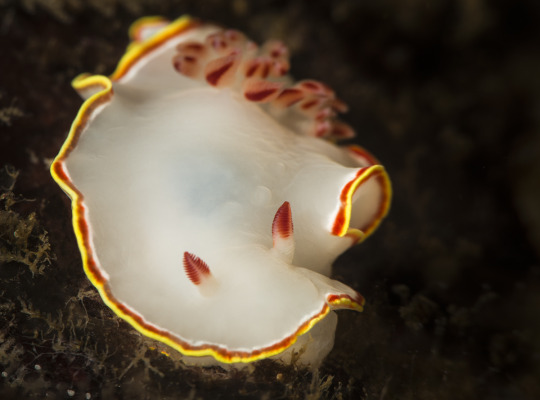
Chromolaichma sedna is a dorid nudibranch found in the eastern Pacific, though it has been introduced through human activity to the western Atlantic. It grows around 6 cm long, and its distinctive red rhinophores and mantle margin earn this species its common name - the 'Red-Tipped Sea Goddess'.
Photo source - valeriamas on iNaturalist
344 notes
·
View notes
Text
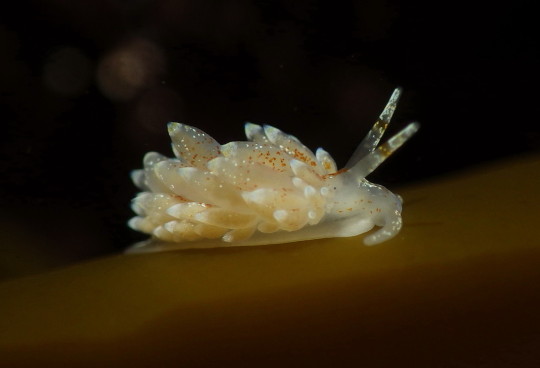
Amphorina pallida is an aeolid nudibranch found in the northern Atlantic ocean. They grow about 1-2cm long, and feed on hydroids. The species' name comes from the first one of these slugs found, which was quite pale ('pallid'), though often this species is colourful!
Photo source - jeffgoddard on iNaturalist
364 notes
·
View notes
Text

Hypselodoris maculosa is a dorid nudibranch found throughout the Indo-West Pacific. While this one taxonomic group was thought to contain a variety of different markings, recent DNA data suggests seven distinct species were under the same name. These slugs grow about 3cm long, and feed on sponges.
Photo source - brentonprigge on iNaturalist
140 notes
·
View notes
Text

Notobryon wardi, also known as the Iridescent Nudibranch, is a nudibranch found in the southeast Atlantic and the Indo-West Pacific. It grows to about 3cm long, and feeds on hydroids.
Photo source - uwkwaj on iNaturalist
321 notes
·
View notes